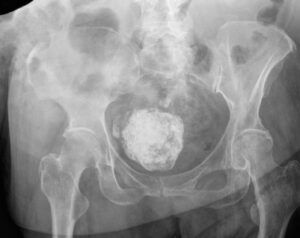Are all fibroids equally problematic? And which size of fibroid is dangerous? Well, fibroid size matters because larger growths can leave you with terrible symptoms, and even send you to the hospital. Recently, Sharon Stone just revealed that, because of a delayed diagnosis, she needed surgery to remove a large fibroid tumor. Worse, she would be facing a 4-6 week recovery period because of the invasive nature of her fibroid treatment. 
Now, many women are diagnosed with uterine fibroids each year. These are non-cancerous tumors that develop in and around your uterus. But not every fibroid diagnosis is the same. In fact, did you know that fibroids can range from almost undetectable to the size of a grapefruit. Or, in extreme cases, the size of a fully-grown fetus? In fact, recently, one woman's grapefruit-sized fibroid made her foot go numb and almost led to an incorrect cancer diagnosis!
Now, any size of fibroid can cause potential complications. In fact, one study shows that in 2017, fibroids sent over 65,000 women to the emergency room. (And that reflected a big jump from 2006, the last year statistics were recorded. Because, that year, just over 23,000 women visited the ER because of fibroid symptoms.)
Of course, that can happen to women with any fibroid size. But, common sense does come into play here. So, the bigger the uterine fibroid, the larger an impact it is likely to have on a woman's health. This is especially true when it comes to side effects like weight gain and uterine bloating.
While most women will seek fibroid treatment early on in the fibroid process, some tumors grow to the "giant" size of 25 pounds or more--that's a lot of extra weight to carry around! In fact, the largest ever recorded fibroid weighed a whopping 140 pounds! In fact, a Singapore woman recently had to have a giant fibroid, weighing 61 pounds removed.
Of course, a woman's uterus expands alongside larger fibroids. Even women with grapefruit-sized tumors will appear to gain more weight than just the extra pounds of their tumors. Larger fibroids can stretch a woman's uterus to the point where she appears to be 4-5 months pregnant. And that's not a look most women seek outside of pregnancy!

Because larger fibroids can take such a toll on a woman's health, it's important to determine the size of a tumor before deciding on the course of treatment.
Women with large fibroids should have them imaged for more exact measurements; once your doctor has those facts, you can decide together whether the tumor should be removed. There is, of course, a risk in delaying or foregoing treatment. Because, if left alone, your fibroids are likely to keep growing, causing more symptoms and unpleasant side effects.
We don't know why women develop fibroids. Or why some fibroids remain small, while others grow large and dangerous. Certain environmental and lifestyle factors may also play a role, including your vitamin D levels and your exposure to certain chemicals, both in the air and in personal care products like hair relaxers.
Typically, there's a range of fibroid sizes. Small growths are usually between 1 and 5 cm, or about the size of a fruit seed. We consider a fibroid medium-sized if it's 10 cm or less, or no larger than an orange. And large fibroids measure above that 10 cm range, getting as large as a watermelon.
Recently, one 45-year old woman had a fibroid that, after delaying treatment, grew to the size of a 28-week fetus! And that's actually a not-unlikely outcome. Because, unfortunately, fibroids left untreated can get even larger than that. In fact, a woman in Brazil recently had a 100-pound fibroid removed from her uterus! Her emergency surgery was triggered by her problems breathing. But that's not the only concern you face when your fibroid gain in size. Larger fibroids may also lead to complications such as:
Because unchecked fibroid growth can lead to many complications, it's important to begin exploring your treatment options as soon as you receive a diagnosis. Once you know how large your fibroids already are, you and your doctor can decide if they should be surgically removed or if other, less invasive options, may help you find relief from your symptoms.
Ready to begin the treatment process? We're here to help, so schedule a consultation today! We can review your scans, and help you decide if minimally invasive treatments such as UFE Treatment will work for your fibroid size.
As leading fibroid specialists in Houston, we can help you get back to doing the things you love – free of pain and symptoms associated with this diagnosis.

Scheduling
Please contact our dedicated specialists to schedule a consultation today.
2025 Houston Fibroids. All rights reserved. Website Design by Healthcare Success